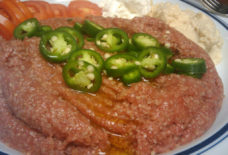An art of war and resilience
Conflict and war have invariably influenced a great deal of artists in this country, particularly the ones who lived through the 1975-90 Civil War. Yet, very few artists have devoted their work to exhaustive documentation of change within Lebanon.
One artist who can be said to have done that is Mouna Bassili Sehnaoui, as is evidenced in “Survivre” (Surviving), the expansive retrospective of her work now up at Aida Cherfan Fine Art Gallery.
“These paintings helped me survive the war,” Bassili Sehnaoui told The Daily Star, “which is why I called the exhibition Surviving.”
“Survivre” amasses an array of the artist’s paintings, etchings, lithographs and mixed-media works (most of which have never been shown before), from the past 40 years. The works chronicle her interpretations of Lebanon’s shifting cultural and socio-political landscape.
Bassili Sehnaoui’s earlier work is marked by a notable sense of macabre pessimism.
“Absolutes,” 35×25 cm, an etching and engraving on copper plate from 1969, features a faceless, partially dismembered figure, ripping open its chest to reveal the ribcage and raw flesh.
“The 1967 war gave me the feeling that nothing would ever be the same again in the Middle East,” Bassili Sehnaoui writes in the monograph accompanying the show, a reference to the 1967 Arab-Israeli war. “Like a body dismembered and torn apart.”
Violence and strife are also communicated in more vibrant ways.
With its bright colors and abstract figures, “Furn Saint Rita,” her 29x39cm gouache on paper work from 1989, departs markedly from some of Bassili Sehnaoui’s more figurative paintings. The “furn” in the work’s title refers to an Arab bakery, while Saint Rita, as the artist describes, is the “saint of lost causes.”
“In those days,” she explained, “if you went out to get your daily bread, you risked [being] killed.”
Everything in the work appears to be in a state of chaos. Bassili Sehnaoui’s multiple layers diffuse visual elements in the same space, creating a montage-like effect. Pieces of flatbread line the center of work as a blue figure lays across the Lebanese flag, as though he has been shot. Another figure above him appears to be screaming.
These elements of terror are offset by a woman to the left of the painting who appears to be sunbathing, carefree, with a plate of watermelon at her side. Perhaps, this dichotomy alludes to the “lost causes” reference Bassili Sehnaoui has incorporated within the title.
Waiting woman is another motif of this exhibition. “The Condolence Visit,” 29.7x42cm, an ink and gouache-on-paper work from 1982, is one of Bassili Sehnaoui’s more-famous examples of this motif.
Eight women sit in a room. In the center appears to be the mother of the younger grieving woman next to her. Their faces are marked by misery as the mother solemnly closes her eyes and the younger woman looks down. The rest of the women do not have any defining facial features. What’s more, the other women’s body language is particularly detached from those two central figures.
“The people who come, their mind is elsewhere,” Bassili Sehnaoui clarified. “They are there to be consoling, but they don’t feel this pain.”
One woman on the far left of the piece noticeably communicates the indifference to which Bassili Sehnaoui refers. She wears a white blouse and black sunglasses and maintains a stance that reads as utterly uninvolved in the rest of the tableau.
This retrospective of Mouna Bassili Sehnaoui’s work offers an intricate perspective of Lebanon’s rich cultural and socio-political history. The works are sure to engage the viewer into questioning many of the contradictions that remain in the country, even today, while offering the opportunity to enjoy an eclectic body of work.
“Survivre” (Surviving), is on view at the Aida Cherfan Gallery through June 25. For further information about the show please contact 04-444-111. Bassili Sehnaoui’s monograph “Survivre” can be found at Antoine bookstores.
Source: www.dailystar.com.lb


